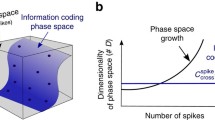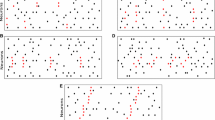Abstract
In Chap. 8, Günther Palm describes his joint work with his colleague, George Gerstein, on introducing and applying different measures for statistical significance of cross-correlations in multiple-neuron spike train recordings.
Access provided by Autonomous University of Puebla. Download chapter PDF
Similar content being viewed by others
Keywords
- Statistical significance
- Spike train correlations
- Cross-correlation
- Data analysis methods
- Multiple-neuron recordings
George’s Stay in Tübingen: Interactions Between Neurons and with Some Untypical Germans
My encounter with George Gerstein was relatively short, only about a year, when he was staying in Tbingen to cooperate with us, i.e., the group of Valentino Braitenberg with Almut Schüz, Joseph Rauschecker, Ad Aertsen, and myself at that time. Still I was deeply impressed by his character and his attitude to neuroscience.
Since I had joined the Max Planck Institute in Tübingen and was drawn into neuroscience, my strongest interaction had been with neuroanatomy. I did have the chance to visit some physiology labs and was impressed but perhaps also confused by the many things they had to worry about and take care of. In contrast to these experiences, when I met George I was impressed by the clarity and simplicity of his ideas. Contrary to most neurophysiologists, he seemed to be truly interested in how the brain tissue he studied really works, rather than how to tell a nice and convincing story about it.
When George came to Tübingen, he was interested in measuring interactions between neurons, possibly by synaptic connections, but essentially expressed in spike correlations. I vividly remember discussions about the three basic “scenarios” for creating a correlation: A influences B, B influences A, or A and B are both influenced by a common cause C. This was accompanied by simple drawings of 3 or 4 neuron networks and the resulting correlations. At that time, we were also discussing George’s “gravity” method, so we also tried to imagine how the neurons would move in “gravity space.” During these imaginative discussions, it was always clear (in the back of our minds) that we were vastly oversimplifying the real situation, where the experimenter has recorded spike trains from a few neurons among a nervous tissue containing many thousands of unobserved neurons. Of course a single spike in one of the recorded neurons can hardly generate a spike in another recorded neuron on its own, without the help of other neurons. And of course a spike correlation from A to B (with a positive delay) can also be an indirect effect via one or several intermediate neurons (or groups of neurons). And it is not even unlikely that two or perhaps all three of the above scenarios for correlation co-occur.
George’s modesty, admitting the vast amount of our ignorance while still trying to find methods of measuring and quantifying the interactions between neurons, was very impressive and convincing, so this is probably what I learned from him. It also confirmed my own view of statistics that in order to show a significant interaction (or some other kind of mechanism supposed to be at work), one does not need to and perhaps should not employ any (more or less) detailed model of it, one should rather invent an appropriate test statistics, which implies a set of predictions that are very surprising under the hypothesis that there is no such mechanism (Palm 2012). This hypothesis can usually be modeled much more easily. This line of reasoning led to our papers on the significance of correlations or co-occurring spikes in the JPSTH (Palm et al. 1988; Aertsen et al. 1989), and later also to investigating higher order interactions (Martignon et al. 1993, 1995), and to simulations showing that such correlations, sometimes called “functional connectivity,” have no simple direct relation to real anatomical connectivity (Aertsen et al. 1994).











References
Aertsen AM, Gerstein GL, Habib MK, Palm G (1989) Dynamics of neuronal firing correlation: modulation of “effective connectivity”. J Neurophysiol 61(5):900–917. https://doi.org/10.1152/jn.1989.61.5.900
Aertsen A, Erb M, Palm G (1994) Dynamics of functional coupling in the cerebral cortex: an attempt at a model-based interpretation. Physica D Nonlinear Phenomena 75(1–3):103–128. https://doi.org/10.1016/0167-2789(94)90278-X
Martignon L, von Hasseln H, Palm G (1993) Modelling stochastic networks: data to the connectivity structure. In: Herzog O, Christaller T, Schütt D (eds) Grundlagen und Anwendungen der Künstlichen Intelligenz—17. Fachtagung für Künstliche Intelligenz, Informatik aktuell, Subreihe Künstliche Intelligenz. Springer, Berlin, pp 50–58. https://doi.org/10.1007/978-3-642-78545-0
Martignon L, von Hassein H, Grün S, Aertsen A, Palm G (1995) Detecting higher-order interactions among the spiking events in a group of neurons. Biol Cybern 73(1):69–81. https://doi.org/10.1007/BF00199057
Palm G (2012) Novelty, information and surprise. Springer, Berlin. https://doi.org/10.1007/978-3-642-29075-6
Palm G, Aertsen AMHJ, Gerstein GL (1988) On the significance of correlations among neuronal spike trains. Biol Cybern 59(1):1–11. https://doi.org/10.1007/BF00336885
Author information
Authors and Affiliations
Corresponding author
Editor information
Editors and Affiliations
Rights and permissions
Copyright information
© 2023 The Author(s), under exclusive license to Springer Nature Switzerland AG
About this chapter
Cite this chapter
Palm, G. (2023). Significance of Spike Train Correlations. In: Aertsen, A., Grün, S., Maldonado, P.E., Palm, G. (eds) Introducing Computation to Neuroscience . Springer Series in Computational Neuroscience. Springer, Cham. https://doi.org/10.1007/978-3-030-87447-6_8
Download citation
DOI: https://doi.org/10.1007/978-3-030-87447-6_8
Published:
Publisher Name: Springer, Cham
Print ISBN: 978-3-030-87446-9
Online ISBN: 978-3-030-87447-6
eBook Packages: Biomedical and Life SciencesBiomedical and Life Sciences (R0)




